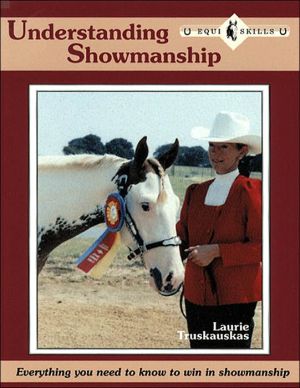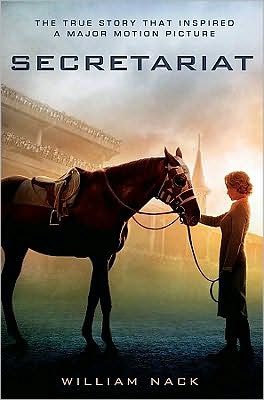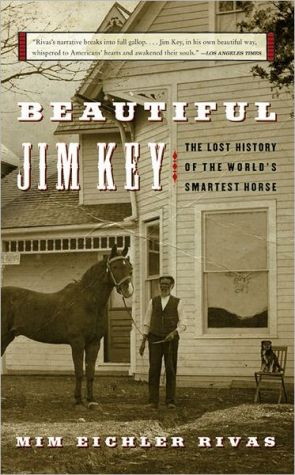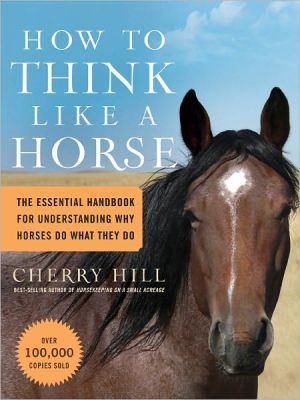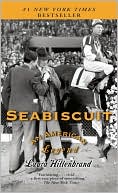Understanding Showmanship: Everything You Need to Know to Win in Showmanship Classes
Showmanship classes have some of the fastest growing entries in horse shows across the nation. Now there's a book to guide you step-by-step to that blue ribbon.\ Clear straightforward instruction and lots of photo series make learning easy and effective.
Search in google:
Showmanship classes have some of the fastest growing entries in horse shows across the nation. Now there's a book to guide you step-by-step to that blue ribbon. Clear straightforward instruction and lots of photo series make learning easy and effective. American Quarter Horse Journal This is a great teaching and training aid for youth showmanship competitors who are seroius about winning. From dressing for success to grooming for grandeur, Truskauskas covers all the elements that meke an eye-catching horse and handler. There are patterns to practice, grooming tips and secrets to getting noticed and scored well. The book is generously illustrated with black-and-white photos; it would have been a spectacular book in full color. The subtitle, "Everything you need to know to win in showmanship classes," is absolutely true, There are no shortcuts to a well-presented horse, and this book should put you on the right track.
WHAT IS SHOWMANSHIP?\ Showmanship is the art of showing a horse at halter. The horse himself is not judged. The horse is merely a prop that you use to demonstrate your ability to show a horse to his best advantage. You are judged on your ability to fit or to properly condition a horse as well as on your ability to present yourself professionally and properly and to show the horse as you would a halter horse. You are judged on the neatness of your attire, the cleanliness of your tack, and the execution of your pattern.\ Although you are being judged, not your horse, you are being judged on your ability to show a horse. Therefore, the horse is where you should aim most of your attention. You must be aware, at all times, of where the judge is located in relation to you and your horse. Yet, first and foremost, you must be sure that your horse is standing correctly and has not cocked a leg, moved “out of square,” or done any number of other things that an enterprising horse may try to do to break up the monotony of the class. If your only reason for showing in this class is to show off your new outfit or your new figure, find a beauty pageant. If you want to participate in showmanship and show a horse, you must learn to be aware at all times of where the judge is and of what your horse is doing. You want your horse to look his best at all times. Over-presenting yourself is a large turnoff to many judges. The American Quarter Horse Association (AQHA) rules specifically state: “The exhibitor should appear businesslike, stand and move in a straight, natural, and upright manner, and avoid excessive, unnatural, or animated body positions.”\ Showmanship originated as a way to teach a handler how to best show a horse at halter. In a halter class, the horses are divided by age and sex, and the horse himself is judged. In a halter class, you show the horse. Your handling ability is not judged. Yet, the way in which you present your horse can add or detract from the appearance of the horse and therefore affect the horse’s final placement. For that reason, it is wise to study the mechanics of showing at showmanship to understand how to better show your horse at halter, even if you choose never to show in a showmanship class. However, showmanship is a fun class that can be mastered easily. It is easier to train a horse to lead and set up correctly than it is to teach him to perform a reining pattern, jump a course of eight fences, or move slowly yet correctly in a western pleasure class. Another benefit of showmanship is that you do not need to own a superior halter horse or a top moving hunter or pleasure horse to place well. You must, however, do your homework and teach your horse to move correctly on the ground and to be obedient to your every body movement and cue in order to place in a top-level showmanship class. Showmanship is often the first class in which a new competitor will begin to do well, and doing well in one class gives you the incentive to try other classes. Showmanship is the class in which I began winning consistently as a child, and those ribbons gave me the incentive to keep trying until I began to place in other riding classes. (My very first ribbon was in a musical chairs class—a fifth place, green rosette.)\ THE ART OF SHOWING\ A HORSE\ As I mentioned earlier, showmanship is an art. You must be proud of your horse to show him, because that attitude will be evident in how you present your horse. Dragging the horse along behind you tells a judge that you have not done your homework and taught your horse to lead correctly, nor do you care enough about placing in this class to spend the time learning and training your horse to be competitive. You cannot pull a horse out of the pasture on a Saturday night and expect him to do well at showmanship on Sunday. You must teach him to lead and to back up, to set up, to perform the 360 (planting his hind pivot foot in the ground), and to hold his square position as you move back and forth in front of him. I use the “quarter method” of showing, which will be described in Chapter 7.\ TRAINING\ Training a horse to perform the maneuvers required in a showmanship class does not require as large a commitment of time as do some of the other more demanding classes. However, your showmanship horse must be clean and conditioned, and he must obey your slightest command by barely a whisper of a lead-line cue. After a period of time, if a horse is trained consistently, he will learn to interpret your body language as his cue to perform. At that point, you should be able to put in a competitive round in a showmanship class.\ CONFORMATION\ While your showmanship horse does not need to have the conformation of a superior halter horse, at the higher levels of showing, a nicely conformed horse with an eye-catching presence will often make the difference between a first and second place. That is not to say that you can’t beat the more nicely built horse, because you certainly can if you put in your time and train your horse well. But if two handlers are equal in their showmanship performance, many times the ribbon will go to the more eye-catching horse that shows charisma. If your goal is to buy a new showmanship horse, keep that thought in mind.\ CONDITIONING\ Conditioning plays a large part in the appearance of your horse, and it shows that you care enough about your horse and about your placing in this class to do well. A well-conditioned horse always looks better than an overweight, out-of-condition horse. Conditioning does not happen overnight. It must be done right so as not to stress your horse and cause him to become sore or lame. Working an overweight horse too hard, too soon, can cause him to pull a muscle, bow a tendon, become colicky, tie up, or endure many other complications that can be avoided simply by building him up to good condition slowly and thoughtfully. In thirty days you will see your horse begin to improve, and you just keep building on that.\ Conditioning takes time and effort on your part. Not only will your well-conditioned horse do better or place higher in his showmanship class, he will feel better, look better, and stay healthier. Even if a showmanship class is not in your near future, conditioning should be part of your horse’s normal routine if only to keep him healthy. A horse is not much different than a person who works in an office all week, sitting at a desk, then tries to jog ten miles or play three games of tennis on the weekend. He will be sore from overexertion because his body is not properly conditioned to handle the demands placed on his muscles. Along the same line, if you let an out-of-condition horse out to play in a pasture or paddock, he is more prone to sustaining strains and pulls because of his lack of fitness. Conditioning makes good sense for both horse and handler.\ A young horse can be lightly conditioned, but be careful that young, growing bones and tendons are not stressed. Some problems that occur at a young age are irreversible. A young horse that is fed too much to make him grow faster can develop osteochondrosis dessicans (OCD), which occurs when bone growth is too fast and too soft to accommodate the tendon and muscle mass. The lower bones of the legs bow forward because of the pull on the back of the tendon.\ TEACHING SHOWMANSHIP MANEUVERS\ Teaching your horse the showmanship maneuvers makes sense not only for showmanship class, but for safety reasons as well. Learning to lead, stand, and obey your requests from the ground teaches a horse to be mannerly, obedient, and safe. Showmanship maneuvers, the quarter method in particular, came into being to promote safety when working with a thousand-plus-pound animal controlled by only a small strap of leather.\ The object of showmanship is for you, the handler, to learn to move in such a manner that the judge always has a clear, unobstructed view of your horse. When he is at the left front of the horse, you will stand on the right front of the horse. Standing in that position allows him an unobstructed view of the horse and allows you to pull your horse’s head away from the judge if your horse tries to nip or bite him. When the judge progresses to the hindquarters, you move to the same side of the horse as the judge, yet you do not block his view because, even though you face the horse, you stand to the side and slightly to the front of him. The reason for moving to this position is, again, for safety. If you need to, you can pull the horse’s head toward you and his hindquarters will swing harmlessly away from the judge.\ Learning to be respectful on the ground also helps a horse to be respectful under saddle. Good ground training and proper manners will do much toward having a safe and obedient horse to handle, both on the ground and when you are on his back. A horse that thinks he is a playmate is not safe or fun for anyone to work with. Teach your horse good ground manners right from the start and you will be well on your way to teaching the showmanship maneuvers.\ Your horse must be obedient to the whoa command, which helps with ground work and when you ride. Your horse must learn to obey your requests without question so that you both can enjoy a long and successful relationship whenever and wherever you work around him.
What is Showmanship Vocabulary Choosing the right horse for showmanship classes The Quarter Horse method of showing Teaching the maneuvers Learning the ring patterns Conditioning, trimming, and shoeing Grooming for the ring Clipping your horse Banding the western horse Choosing the right tack Your clothes and color coordination Presentation of you and your horse Pointers for a winning performance Common mistakes Showing the English horse French braiding the mane Button braids Braiding the tail Understanding scoring
\ American Quarter Horse JournalThis is a great teaching and training aid for youth showmanship competitors who are seroius about winning. From dressing for success to grooming for grandeur, Truskauskas covers all the elements that meke an eye-catching horse and handler.\ There are patterns to practice, grooming tips and secrets to getting noticed and scored well.\ The book is generously illustrated with black-and-white photos; it would have been a spectacular book in full color.\ The subtitle, "Everything you need to know to win in showmanship classes," is absolutely true, There are no shortcuts to a well-presented horse, and this book should put you on the right track.\ \ \ \ \ \ Western HorsemanHer tips about showmanship considerations--learning patterns or performing maneuvers to advantage--are especially helpful. . .collectively [they] all contribute to a finely polished performance.\ \
